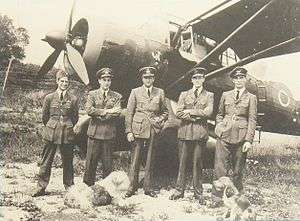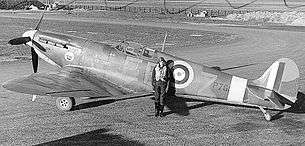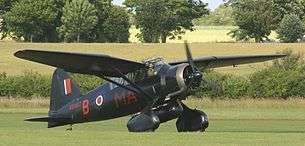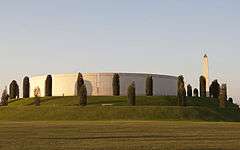Jim McCairns
| Jim McCairns | |
|---|---|
 McCairns, Hugh Verity, Percy Pickard, Peter Vaughan-Fowler and Bunny Rymills with Verity's Lysander in 1943. | |
| Nickname(s) | "Mac" |
| Born |
21 September 1919 Niagara Falls, New York, United States |
| Died |
13 June 1948 (aged 28) near RAF Finningley, England |
| Buried at | East Retford, Nottinghamshire |
| Allegiance | United Kingdom |
| Service/branch | Royal Air Force |
| Years of service | 1939–1948 |
| Rank | Flight Lieutenant |
| Service number | 754718 and 125754. |
| Unit |
No. 616 Squadron RAF No. 161 Squadron RAF No. 3 Squadron RAF No. 56 Squadron RAF |
| Battles/wars | Second World War |
| Awards |
Distinguished Flying Cross & Two Bars Military Medal Croix de guerre (France)[1] |
| Relations | Moira McCairns |
James Atterby "Jim" McCairns, DFC & Two Bars, MM (21 September 1919 – 13 June 1948) was an English pilot with the Royal Air Force. He flew the Supermarine Spitfire fighter before becoming a prisoner of war, escaping and returning to England. He returned to active service as a "special duties" pilot working with Special Operations Executive, carrying agents to and from occupied France, before returning to combat in 1945 as a successful fighter pilot. He was decorated for gallantry five times and was killed in an air crash in 1948.
Early life
McCairns was born on 21 September 1919 in Niagara Falls, New York, United States,[2] the son of Kate Elizabeth and Thomas McCairns an English engineer who was working in the United States.[3] His mother brought him to England for the first time aboard the ocean liner Regina sailing from Montreal and arriving in Liverpool on 18 June 1922. They visited family at Brigg, Lincolnshire before returning to Quebec on 30 September 1922 aboard the ocean liner Canopic. The family returned to England on 30 September 1930 from Boston, Massachusetts aboard the liner Duchess of York ,[4] the family settled at 20 Chapelgate, Retford,[5] and he completed his education at King Edward VI Grammar School, Retford.
Royal Air Force
He had an early fascination for flight and joined the Royal Air Force Volunteer Reserve in March 1939 as a trainee pilot, service number 754718. He completed his basic training and progressed through flight training to earn his pilot’s wings aircrew brevet. On 14 October 1940 sergeant pilot McCairns joined No. 616 Squadron RAF flying Supermarine Spitfire fighters and was operational a short time later.[6] Flying with the squadron from RAF Tangmere under the command of Douglas Bader on 30 June 1941 McCairns had a close call during an offensive sweep over occupied France when his aircraft was hit and explosive shells entered his cockpit. He retained control of his Spitfire and nursed it home to land safely.[7]
Prisoner of war

On 6 July 1941 after applying for a commission in the morning he was flying over the French coast with Douglas Bader when the squadron was involved in a fast moving combat with Messerschmitt Bf 109 fighters from which McCairns did not return. Initially posted as missing in action his aircraft Supermarine Spitfire Mark IIa (serial number “P8500”) was positively identified by its squadron code letters painted on the fuselage when sighted by another member of the squadron on 8 July 1941, crash landed near the beach at Gravelines-Dunkirk.[8][9] His cockpit canopy jammed in the crash and he was fortunate that the Spitfire did not catch fire, he had to be released by German soldiers.[10] The records of No. 616 Squadron later recorded that he was "a very capable and keen pilot" and also that his status was "prisoner of war, slightly wounded".[11]
Held at Oflag IX-C Spangenberg McCairns was interested in escape activities and made a failed attempt to get away on 22 January 1942 by breaking out of the prison camp which was within a castle and accompanied by a Belgian officer prisoner made a good distance away from Spangenberg.[12] He travelled across Germany alone after they were separated and crossed the frontier with Belgium on foot and exhausted during the terrible blizzard of 1942.[13] Unable to communicate easily he was fortunate to make contact with the Belgian resistance network who sent him to Brussels where he was put in touch with a Belgian agent who had been parachuted back into occupied Belgium from an RAF bomber some months before. London was made aware of his escape by the agent and guides and passage arranged to Gibraltar which he successfully reached via France and Spain.[14]
Back in England and an introduction to covert operations
Once in Gibraltar he was debriefed by Lieutenant James Langley of MI9 British Intelligence escape organisation. McCairns discussed with a Westland Lysander equipped taxi-service flying from England and operating to and from the occupied countries to insert and extract agents and escaped prisoners of war. Langley agreed with the idea and made it official.[15] Back in England and promoted temporary flight sergeant, McCairns was congratulated on his successful escape and awarded the Military Medal on 14 August 1942 for his bravery and achievement,[16][17] before commencing a lecture tour for airmen who might at some stage have similar experiences.
Originally refused permission to fly the aircraft for these operations due to his junior rank, lack of the required 500 hours night-flying experience, inability to speak fluent French and a ruling forbidding escaped prisoners of war to fly over German occupied lands, he and Langley fought their case and won.[18][19] He applied for and gained a commission as pilot officer on 1 May 1942, service number 125754.[20] McCairns received intensive training and proved his ability to fly the Westland Lysander at night finally gaining approval from Wing Commander Edward Fielden in command of No. 161 Squadron RAF at RAF Tempsford which provided aerial support of all types for Special Operations Executive.[21] The Lysander pilots would fly low and slowly across the English Channel and cross the French coastline, then head to their allocated area, where the French resistance would signal a pre-arranged code before lighting up a makeshift runway across a field, hoped to be flat enough to land a Lysander. The pilot would land his aircraft down for the agents to climb down while any returning passengers climbed aboard and he would then hope to take off again before the Germans arrived. Problems were sometimes encountered with aircraft getting stuck in waterlogged fields, bushes and small trees causing damage and animals straying into the way.
Wing Commander Percy Pickard assumed command of the squadron in October 1942, and McCairns flew his first "special duties" mission as co-pilot to Pickard on the night 22 November 1942 when a pair of Lysanders landed in France to insert 2 agents and bring 3 back to England safely.[22] He was promoted flying officer on 1 November 1942.[23]
Special Duties pilot for SOE

On the night of 25–26 November 1942 he flew his first solo mission delivering two agents into France and returned with two passengers, one of them Colonel de Linares, military assistant to General Henri Giraud.[24] Over the next thirteen months he flew 33 more covert missions for SOE of which 25 were successful, a greater success rate than any other pilot.[25] Nineteen of his missions were highly risky “double Lysander” missions which involved both aircraft landing in the selected field and taking off again before being caught. On 13 April 1943 the London Gazette announced the award of a Distinguished Flying Cross to McCairns.[26] It was not a full citation due to the nature of his missions:
Flying Officer James Atterby McCAIRNS, M.M. (125754), Royal Air Force Volunteer Reserve, No. 161 Squadron.This officer has completed many sorties, most of them of a hazardous nature. He is a courageous and determined pilot who has set an example worthy of the highest praise.
The majority of McCairns missions were relatively uneventful, his most dangerous one being his return flight to RAF Tangmere after hitting a twelve-foot-tall poplar tree on final approach to a field near Amboise on the night of April 14/15, 1943. Thinking only a radio aerial had been torn away, he took off but realised immediately that he had a more serious problem. However, he managed to fly back to Tangmere and after landing found that the spinner, the centre boss of the propeller, was badly dented on one side and that the tailplane was attached by only one bracket held on by a single screw.[27] On 10 August 1943 the London Gazette announced his award of a Bar to the Distinguished Flying Cross.[28] Again the citation was brief due to the nature of his work:
Flying Officer James Atterby MCCAIRNS, D.F.C., M.M. (125754), Royal Air Force Volunteer Reserve, No. 161 Squadron.This officer has completed numerous sorties displaying a high degree of skill and determination throughout.
In September 1943 he, the squadron commander Squadron Leader Hugh Verity and McCairns' usual partner on "double Lysander”"missions Peter Vaughan-Fowler, carried out the squadron’s first treble Lysander aircraft operation which was successful. On returning safely to RAF Tangmere McCairns recounted that he had flown at low level along the Loire waiting for his turn to land and had heard a strange “phitt” sound in the cockpit. The next morning his ground crew showed him two round holes in the side windows of his cockpit. A bullet had entered the cockpit and must have missed his nose by just three inches.[29] His last mission with No. 161 Squadron was on 16–17 December 1943.[30] after flying in and returning with many British, French and Belgian SOE agents and similar covert operations personnel and flying out a series of Commonwealth and US airmen who had escaped from prison camps or evaded capture after being shot down.
McCairns was awarded a second Bar to the Distinguished Flying Cross on 14 January 1944.[31]
Later RAF career
Following his highly successful tour with No. 161 Squadron he was posted to a staff position involved in the identification of proposed landing sites for Westland Lysander and much larger Lockheed Hudson aircraft involved in clandestine operations. McCairns was promoted flight lieutenant on 1 May 1944.[32] Wishing to return to operational flying he converted back to fighters and flying Hawker Tempests with No. 3 Squadron RAF attacked a Luftwaffe in the same area Messerschmitt Bf 109 south of Hildesheim, Germany on 28 February 1945 damaging it and moments later shared in the destruction of a Siebel Si 204 in the same area.[33][34] Soon afterwards he transferred to No. 56 Squadron RAF as a flight commander and was involved in an inconclusive combat on 15 April 1945[35] Post-war McCairns transferred to the re-constituted Royal Auxiliary Air Force from 3 May 1947 as a flight lieutenant service number 91315,[36] returning to serve with No. 616 Squadron.[37]
Death

On 13 June 1948 flying a De Havilland Mosquito (serial number “NT423”) he was killed when an engine failed at low altitude and the aircraft nose dived into the ground near RAF Finningley, Yorkshire.[38][39]
The Times Monday on 14 June 1948 reported:
A Mosquito aircraft of 616 South Yorkshire Squadron Royal Auxiliary Air Force, crashed and burst into flames a mile east of Finningley RAF Station to-day when on a local flight. The pilot Flying Officer J A McCairns DFC MM who lived near Bawtry, and a serving airman whose next-of-kin are not yet notified, were killed. The ground crews heard one of the engines making an unusual noise and saw the aircraft bank round the airport and nose-dive to the ground.
He is commemorated on the National Arboretum Armed Forces Memorial.[40]
References
- ↑ Hunt (1992), p.405
- ↑ Verity (2013), p.58
- ↑ Chichester Website – James McCairns
- ↑ Passenger Lists, arrivals in the UK – 1922 and 1930
- ↑ Comet Escape Line website – J A McCairns
- ↑ Burns (1990), p.170
- ↑ Burns (1990), p.166
- ↑ Franks (1997), p.125
- ↑ Burns (1990), p.170
- ↑ Hunt (1992), p.404
- ↑ National Archives, London. Air 27/2524 – 616 Squadron ORB
- ↑ Chichester Website – James McCairns
- ↑ National Archives, London. WO 373/61/917 – JA McCairns recommendation for Military Medal
- ↑ [Comet Escape Line website – J A McCairns ]
- ↑ Burns (1990), p.59
- ↑ The London Gazette: no. 35671. pp. 3606–3607. 14 August 1942.
- ↑ National Archives, London. WO 373/61/917 – JA McCairns recommendation for Military Medal
- ↑ Verity (2013), p.58
- ↑ Chichester Website – James McCairns
- ↑ The London Gazette: (Supplement) no. 35654. pp. 3412–3413. 31 July 1942.
- ↑ Verity (2013), p.59
- ↑ Verity (2013), p.59
- ↑ The London Gazette: (Supplement) no. 35858. pp. 273–274. 8 January1943.
- ↑ Verity (2013), p.206
- ↑ Chichester Website – James McCairns
- ↑ The London Gazette: (Supplement) no. 35981. pp. 1743–1744. 13 April 1943.
- ↑ Chichester Website – James McCairns
- ↑ The London Gazette: (Supplement) no. 36131. pp. 3629–3630. 13 August 1943.
- ↑ Chichester Website – James McCairns
- ↑ Verity (2013), p.217
- ↑ The London Gazette: no. 36329. pp. 285–285. 11 January 1944.
- ↑ The London Gazette: (Supplement) no. 36520. pp. 2286–2287. 16 May 1944.
- ↑ National Archives, London. Document Air 50/4/128. Combat report F/Lt JA McCairns
- ↑ Hunt (1992), p.405
- ↑ National Archives, London. Document Air 50/22/295 – combat report F/Lt J A McCairns
- ↑ The London Gazette: (Supplement) no. 37987. pp. 2720–2721. 13 June 1947.
- ↑ Hunt (1992), p.411
- ↑ RAF Commands – death of J A McCairns DFC**MM
- ↑ Hunt (1992), p.411
- ↑ "Personal Details: McCairns, James Atterby". Armed Forces Memorial roll of honour. GOV.UK. Retrieved 30 August 2016.
Bibliography
- Hunt, Leslie (1992). Twenty-one Squadrons: the history of the Royal Auxiliary Air Force. London: Crecy. ISBN 0947554262.
- Burns, Michael (1990). Bader, the man and his men. London: Arms and Armour. ISBN 1854092464.
- Franks, Norman (1997). Royal Air Force Fighter Command Losses, Volume 1. Earl Shilton: Midland Counties. ISBN 1-857800559.
- Verity, Hugh (2013). We Landed by Moonlight. Crecy Publishing. ISBN 9780947554750.
- Foreman, John (1996). The Fighter Command War Diaries. Walton-on-Thames: Air Research. ISBN 1-871187-34-6.
- M. R. D. Foot (2006). SOE in France. Routledge. ISBN 0415408008.
- Shores, Christopher (1999). Aces High, Volume 2. London: Grub Street. ISBN 1-898697-00-0.
- Foreman, John (2005). RAF Fighter Command Victory Claims, Part Three. Walton-on-Thames: Red Kite. ISBN 0-9546201-5-1.